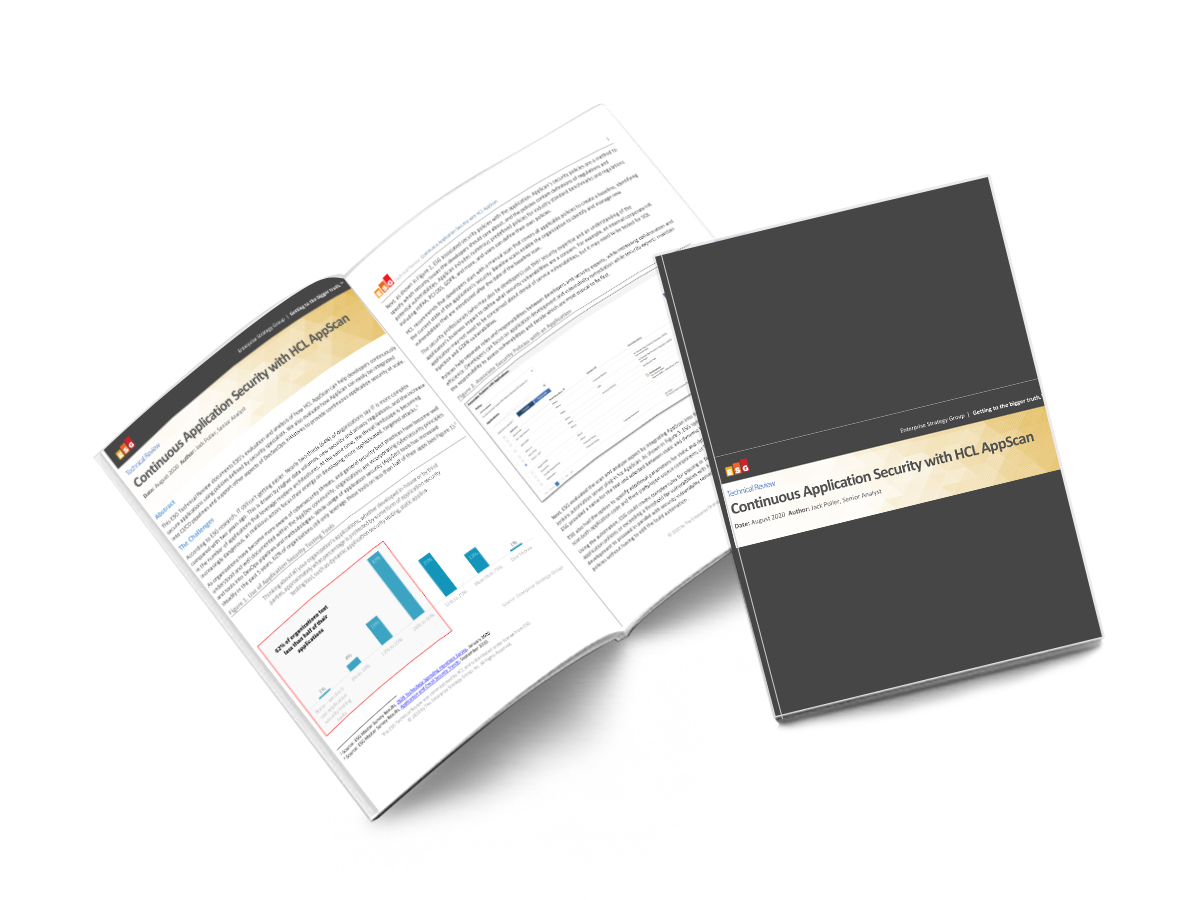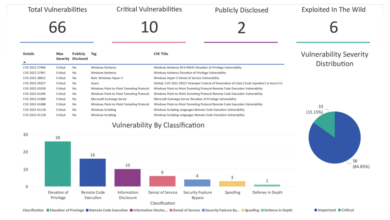
AppScan Continuous Security White Paper A Deep Dive
AppScan Continuous Security white paper: Ever felt like you’re playing whack-a-mole with application security vulnerabilities? This paper dives deep into how AppScan Continuous Security can help you automate the process, shifting from reactive patching to proactive prevention. We’ll explore its key features, seamless integration into your development workflow, and how it empowers you to build secure applications from the ground up.
Get ready to ditch the endless cycle of security breaches and embrace a more streamlined, efficient approach.
This isn’t just another technical manual; it’s a practical guide to transforming your security strategy. We’ll walk you through real-world examples, best practices, and even a few troubleshooting tips. Whether you’re a seasoned security pro or just starting your journey, this paper will equip you with the knowledge and tools to elevate your application security game. Prepare for a smoother, more secure development lifecycle.
Introduction to AppScan Continuous Security
AppScan Continuous Security is a powerful application security testing (AST) solution designed to seamlessly integrate into your software development lifecycle (SDLC). It automates the process of identifying and remediating security vulnerabilities throughout the development process, significantly reducing the risk of deploying insecure applications. This proactive approach helps organizations shift security left, embedding security practices early and often.The core functionality revolves around automated static and dynamic analysis of your application code.
Static analysis examines the code without actually running it, identifying potential vulnerabilities based on coding patterns and known weaknesses. Dynamic analysis, on the other hand, tests the running application, simulating real-world attacks to uncover vulnerabilities that might not be apparent through static analysis alone. AppScan Continuous Security consolidates these techniques, providing a comprehensive view of your application’s security posture.
Benefits of Integrating AppScan Continuous Security into the SDLC
Integrating AppScan Continuous Security into the SDLC offers numerous advantages. Early detection of vulnerabilities reduces remediation costs significantly. Fixing a bug in the early stages of development is far less expensive and time-consuming than addressing it after release. Moreover, this integrated approach ensures that security is not an afterthought, but rather an integral part of the development process, fostering a security-conscious culture within the development team.
This leads to higher quality, more secure software releases, reducing the risk of costly breaches and reputational damage. For example, imagine a vulnerability discovered during development; fixing it then might only cost a few developer hours, whereas discovering the same vulnerability post-release could lead to costly patches, potential downtime, and damage to customer trust.
Types of Security Vulnerabilities Detected by AppScan Continuous Security
AppScan Continuous Security is capable of detecting a wide range of security vulnerabilities. These include, but are not limited to, SQL injection flaws, cross-site scripting (XSS) vulnerabilities, cross-site request forgery (CSRF) attacks, insecure authentication mechanisms, and insecure data handling practices. It can also identify vulnerabilities related to sensitive data exposure, insecure configuration settings, and potential denial-of-service (DoS) weaknesses.
The specific vulnerabilities detected will depend on the type of application being analyzed and the specific configuration of AppScan Continuous Security. A web application, for example, might be vulnerable to XSS attacks, while a mobile application might have vulnerabilities related to insecure data storage. The tool’s ability to cover various vulnerability types is a key strength.
Key Features and Capabilities

AppScan Continuous Security offers a robust suite of features designed to seamlessly integrate security testing into the software development lifecycle (SDLC). Its automated capabilities significantly reduce the time and resources required for comprehensive security assessments, ultimately leading to more secure applications. This section delves into the core features, integrations, and process streamlining benefits of AppScan Continuous Security.AppScan Continuous Security’s automated security testing capabilities are a game-changer.
It leverages a combination of static and dynamic analysis techniques to identify a wide range of vulnerabilities, from SQL injection and cross-site scripting (XSS) to insecure authentication and authorization flaws. The platform’s automated scans can be triggered on various events, such as code commits, build completion, or deployment to a testing environment, ensuring continuous monitoring of the application’s security posture throughout the development process.
This proactive approach allows developers to address security issues early in the SDLC, minimizing the cost and effort of remediation.
Integration with Development Tools and Platforms
AppScan Continuous Security boasts extensive integration capabilities, designed to seamlessly integrate with popular development tools and platforms. This eliminates the need for manual data transfers and promotes a smooth workflow. The platform integrates with leading CI/CD pipelines such as Jenkins, GitLab CI, and Azure DevOps, enabling automated security testing as part of the build and deployment process. Integration with popular IDEs like Eclipse and Visual Studio further enhances developer productivity by providing immediate feedback on code security.
Furthermore, it integrates with issue tracking systems like Jira and ServiceNow, facilitating efficient vulnerability management and remediation. This comprehensive integration approach ensures that security is embedded throughout the entire software development process.
Streamlining the Security Testing Process
AppScan Continuous Security significantly streamlines the security testing process by automating many time-consuming tasks. For example, the automated scanning capabilities eliminate the need for manual testing, freeing up security professionals to focus on more complex issues. The platform’s intuitive interface and comprehensive reporting features simplify the process of identifying, prioritizing, and remediating vulnerabilities. The ability to integrate security testing into the CI/CD pipeline ensures that security is considered at every stage of the development process, rather than being an afterthought.
This proactive approach minimizes the risk of security breaches and reduces the overall cost of software development. For instance, a company using AppScan Continuous Security might find that the time spent on security testing is reduced by 50%, allowing developers to focus on feature development.
Comparison with Other Security Testing Tools
The following table compares AppScan Continuous Security with other popular security testing tools. Note that pricing can vary based on factors such as the number of users, projects, and features included. Ease of use is a subjective assessment based on user reviews and industry feedback.
| Feature | AppScan Continuous Security | Tool B | Tool C |
|---|---|---|---|
| Static Analysis | Yes | Yes | Yes |
| Dynamic Analysis | Yes | Yes | Limited |
| Interactive Analysis | Yes | No | Yes |
| CI/CD Integration | Extensive | Limited | Moderate |
| Pricing | Subscription-based | Subscription-based | Per-scan |
| Ease of Use | High | Medium | Low |
| Integration Capabilities | Extensive | Limited | Moderate |
Implementation and Integration

Integrating AppScan Continuous Security into your Software Development Life Cycle (SDLC) can significantly enhance your application security posture. This involves strategically placing AppScan within your existing workflows to seamlessly incorporate security testing throughout the development process, rather than as an afterthought. Successful implementation requires careful planning and consideration of your specific application types and development practices.
The integration process itself varies depending on your existing CI/CD pipeline and chosen tools. Generally, it involves configuring AppScan to connect to your source code repositories, build systems, and potentially, your defect tracking system. This allows for automated scans triggered by events like code commits or build completions. The key is to make the process as frictionless as possible for developers, ensuring that security testing doesn’t become a bottleneck.
Integrating AppScan Continuous Security into Different SDLC Stages
AppScan Continuous Security is designed to fit into various SDLC stages, from early development to deployment. For instance, integrating it into a Continuous Integration (CI) pipeline allows for automated scans after each code commit. This early detection of vulnerabilities significantly reduces the cost and effort of remediation. Integration into Continuous Delivery (CD) pipelines allows for security testing before release to production, providing a final security checkpoint before deployment.
Configuring AppScan for Different Application Types
AppScan Continuous Security supports a variety of application types, including web applications, mobile applications, and APIs. Configuration differs slightly depending on the application type. For web applications, you’ll typically configure AppScan to scan URLs or deployable artifacts. For mobile applications, you might integrate with mobile application testing platforms to scan compiled binaries or APK/IPA files. API scans involve configuring AppScan to interact with the API endpoints, using specifications like OpenAPI or Swagger definitions.
In each case, the specific configuration settings will ensure that AppScan accurately identifies and reports vulnerabilities relevant to the application’s architecture and technology stack.
Best Practices for Implementing AppScan Continuous Security
Effective implementation goes beyond simple integration. Several best practices can maximize the value of AppScan Continuous Security.
Prioritize scans based on risk: Focus on scanning applications with the highest security risk first. This may involve prioritizing applications handling sensitive data or those facing the greatest external threat. Regularly review and refine your scan configurations to ensure accuracy and efficiency. False positives should be carefully investigated and addressed to maintain developer trust and avoid alert fatigue.
Finally, integrate AppScan results into your existing defect tracking system to manage vulnerabilities effectively. This allows for clear tracking of remediation efforts and overall security improvement.
Setting Up and Running a Basic AppScan Continuous Security Scan
This step-by-step guide assumes you’ve already installed and configured AppScan Continuous Security.
- Connect to your source code repository: Configure AppScan to connect to your Git repository (e.g., GitHub, GitLab, Bitbucket) to automatically trigger scans based on code changes.
- Define a scan profile: Create a scan profile that specifies the application type, technologies used, and desired scan depth. This profile will determine the scope and thoroughness of the scan.
- Configure a build trigger: Set up a trigger in your CI/CD pipeline (e.g., Jenkins, Azure DevOps, CircleCI) that initiates an AppScan scan upon a successful build.
- Run a scan: After the trigger is configured, a new scan will automatically begin after each successful build. Monitor the scan progress within the AppScan interface.
- Review and remediate findings: Once the scan is complete, review the reported vulnerabilities. Prioritize critical and high-severity issues and remediate them accordingly.
- Integrate with defect tracking: Link vulnerabilities found by AppScan to your existing defect tracking system (e.g., Jira, Azure DevOps) to track progress and ensure that vulnerabilities are addressed.
Analyzing Scan Results and Remediation
Understanding and acting upon the results of your AppScan Continuous Security scans is crucial for effective vulnerability management. This section will guide you through interpreting the findings, prioritizing remediation efforts, and implementing effective fixes. We’ll cover strategies for efficiently addressing vulnerabilities and minimizing your security risks.
Interpreting AppScan Continuous Security Scan Results
AppScan Continuous Security provides a comprehensive report detailing identified vulnerabilities. The report typically categorizes vulnerabilities by severity (critical, high, medium, low), type (SQL injection, cross-site scripting, etc.), and location within your application. Each vulnerability is accompanied by a detailed description, including the potential impact, the affected code segment, and recommended remediation steps. Pay close attention to the severity levels; critical and high vulnerabilities require immediate attention, while medium and low vulnerabilities can be addressed based on your risk tolerance and prioritization scheme.
The report may also include false positives, which require further investigation to confirm their validity. Don’t hesitate to leverage AppScan’s documentation and support resources for clarification on specific findings.
Prioritizing and Addressing Vulnerabilities
Prioritization is key to effective vulnerability management. A risk-based approach is generally recommended. This involves assessing the likelihood of a vulnerability being exploited and the potential impact of a successful exploit. Consider factors such as the sensitivity of the data involved, the accessibility of the vulnerable component, and the attacker’s capabilities. Prioritize critical and high-severity vulnerabilities first, followed by medium and low-severity vulnerabilities.
A well-defined vulnerability management process should include clearly defined roles and responsibilities, escalation procedures, and regular review meetings to track progress and adjust priorities as needed.
Strategies for Effective Vulnerability Remediation
Effective remediation requires a structured approach. Begin by verifying the vulnerability’s existence and accurately assessing its impact. Then, develop a remediation plan, which should include specific steps to fix the vulnerability, testing procedures to verify the fix, and documentation of the entire process. Employ version control systems to track changes made to the codebase during remediation. After fixing the vulnerability, retest the application to ensure the vulnerability has been successfully eliminated.
Regularly scan your application for new vulnerabilities, as new threats and vulnerabilities emerge constantly. Consider using automated tools to assist with remediation wherever possible to reduce the manual effort and increase efficiency. A well-documented remediation process ensures consistency and accountability, making it easier to track progress and maintain a secure application.
Vulnerability Types, Severity, and Remediation
The following table illustrates examples of different vulnerability types, their severity levels, and recommended remediation steps. Remember that severity levels and remediation steps may vary depending on the specific context and the application’s environment.
| Vulnerability Type | Severity Level | Recommended Remediation | Example |
|---|---|---|---|
| SQL Injection | Critical | Use parameterized queries or prepared statements; validate all user inputs; employ an appropriate web application firewall (WAF). | Malicious SQL code injected into a database query field. |
| Cross-Site Scripting (XSS) | High | Encode user inputs; use output encoding; implement a content security policy (CSP); validate all user inputs. | Malicious JavaScript code injected into a web page. |
| Cross-Site Request Forgery (CSRF) | Medium | Use anti-CSRF tokens; verify the origin of requests; implement appropriate HTTP headers. | Unauthorized actions performed on behalf of a logged-in user. |
| Insecure Direct Object References (IDOR) | Medium | Validate user access rights; use appropriate authorization mechanisms; implement proper input validation. | Unauthorized access to resources based on predictable URLs. |
Advanced Features and Use Cases: Appscan Continuous Security White Paper
AppScan Continuous Security offers a robust set of advanced features that extend its capabilities beyond basic vulnerability scanning. These features allow for deeper customization, integration with diverse development workflows, and the generation of highly informative reports, enabling security teams to effectively address application security challenges throughout the software development lifecycle (SDLC). This section explores these advanced features and provides practical examples of their application in various scenarios.
Custom Rule Creation and Management
AppScan Continuous Security empowers security professionals to create and manage custom rules, extending its detection capabilities beyond the built-in rule sets. This is particularly valuable for identifying vulnerabilities specific to an organization’s unique technology stack or coding practices. For example, a company using a proprietary authentication mechanism can create a custom rule to detect potential weaknesses in its implementation.
The process typically involves defining the vulnerability pattern, specifying the relevant code elements, and setting the severity level. Custom rules can be easily integrated into existing scans, ensuring continuous monitoring for these specific vulnerabilities. Regular review and updating of custom rules are essential to maintain their effectiveness and accuracy.
Integration with Agile and DevOps Environments
Seamless integration with popular Agile and DevOps tools is crucial for effective security in modern development practices. AppScan Continuous Security achieves this through its APIs and plugins, allowing it to be incorporated into CI/CD pipelines. In an Agile environment, AppScan can be triggered automatically after each sprint, providing immediate feedback on the security posture of newly developed code. In a DevOps setting, AppScan can be integrated into automated build and deployment processes, ensuring that security checks are performed at every stage of the pipeline.
This proactive approach helps to identify and remediate vulnerabilities early, reducing the overall risk and cost associated with security flaws. For instance, integrating AppScan with Jenkins allows for automated security testing within the build process, halting the deployment if critical vulnerabilities are detected.
Addressing Specific Application Security Challenges, Appscan continuous security white paper
AppScan Continuous Security is equipped to handle a wide range of application security challenges. For example, it can effectively identify SQL injection vulnerabilities, cross-site scripting (XSS) flaws, and insecure authentication mechanisms. Its ability to analyze both static and dynamic code allows for a comprehensive assessment of application security. Furthermore, its support for various application technologies, including web applications, mobile applications, and APIs, ensures broad coverage.
Consider a scenario where an organization is concerned about the security of its RESTful APIs. AppScan Continuous Security can be used to scan these APIs, identifying potential vulnerabilities such as insecure authentication and authorization mechanisms, data exposure, and injection attacks. The results can then be used to guide remediation efforts, ensuring that the APIs are secure and protect sensitive data.
Generating Detailed Reports from Scan Results
AppScan Continuous Security provides comprehensive reporting capabilities, enabling security teams to understand and communicate security findings effectively. A typical report includes a summary of the scan, a detailed list of identified vulnerabilities with their severity levels, locations within the application code, and recommended remediation steps. The report should also include information on the scan parameters, the date and time of the scan, and the version of AppScan used.
A well-structured report might include sections for: Executive Summary (high-level overview of findings), Vulnerability Details (specific vulnerabilities, their severity, and location), Remediation Recommendations (detailed steps for fixing vulnerabilities), and Scan Summary (overall scan statistics and parameters). This allows stakeholders to easily understand the security posture of the application and prioritize remediation efforts accordingly. The detailed nature of the reports allows for efficient collaboration between development and security teams, ensuring that vulnerabilities are addressed promptly and effectively.
Security Best Practices with AppScan Continuous Security
Integrating security testing early and often is crucial for building secure applications. AppScan Continuous Security empowers developers to achieve this by seamlessly integrating security testing into the Software Development Life Cycle (SDLC). This approach significantly reduces the cost and effort associated with fixing vulnerabilities later in the process, when they become exponentially more difficult and expensive to address. By proactively identifying and mitigating risks, you enhance the overall security posture of your applications and protect your organization from potential breaches.AppScan Continuous Security offers a robust set of features that enable efficient and effective security testing.
Its integration with various development tools and platforms streamlines the workflow, allowing security professionals and developers to collaborate effectively. By understanding and applying the best practices Artikeld below, organizations can maximize the value of AppScan Continuous Security and significantly improve the security of their applications.
Early Integration of Security Testing
Shifting security left, meaning incorporating security testing early in the SDLC, is paramount. By integrating AppScan Continuous Security into your CI/CD pipeline, vulnerabilities are identified during the development phase, reducing the time and cost associated with remediation. This proactive approach minimizes the risk of deploying insecure applications into production. For example, integrating AppScan into a Jenkins pipeline allows for automated security scans after each build, flagging potential issues before code is merged into the main branch.
This prevents insecure code from being deployed to staging or production environments.
Preventing Common Application Security Vulnerabilities
AppScan Continuous Security helps prevent common vulnerabilities such as SQL injection, cross-site scripting (XSS), and cross-site request forgery (CSRF). By automatically scanning code for these vulnerabilities, developers receive immediate feedback and can address them promptly. For instance, a scan revealing a potential SQL injection vulnerability in a database query will provide the developer with specific details about the vulnerable code segment, allowing for targeted remediation.
This reduces the likelihood of attackers exploiting these weaknesses. Regular scans ensure that new vulnerabilities introduced during development are detected and addressed before they can be exploited.
Best Practices Checklist for AppScan Continuous Security
Effective utilization of AppScan Continuous Security requires a strategic approach. Following these best practices will optimize its effectiveness and contribute to a more secure development process.
- Integrate AppScan into your CI/CD pipeline: Automate security testing as part of your build and deployment process.
- Configure appropriate scan settings: Tailor scan parameters to your specific application and development environment for optimal results.
- Regularly update AppScan: Ensure you are using the latest version to benefit from the latest vulnerability detection capabilities and performance improvements.
- Prioritize vulnerability remediation: Focus on addressing critical vulnerabilities first, based on severity and potential impact.
- Use AppScan’s reporting features: Leverage the detailed reports to track progress, identify trends, and improve your security posture over time.
- Train developers on secure coding practices: Educate developers about common vulnerabilities and how to prevent them.
- Establish a clear vulnerability management process: Define roles, responsibilities, and workflows for handling identified vulnerabilities.
- Regularly review and update your security policies: Ensure your security policies are aligned with the latest industry best practices and regulatory requirements.
Closure
Ultimately, the AppScan Continuous Security white paper showcases a powerful shift in how we approach application security. By integrating automated testing early and often, we move beyond reactive fixes and embrace a proactive, preventative model. The result? More secure applications, reduced risk, and a significant boost in developer productivity. It’s time to stop chasing vulnerabilities and start building security directly into your development process.
Download the white paper today and start your journey towards a more secure future!
User Queries
What types of applications does AppScan Continuous Security support?
AppScan supports a wide range of applications, including web applications, mobile apps, and APIs. Specific support might vary depending on the version.
Is AppScan Continuous Security easy to learn and use?
While the full potential requires some learning, the initial setup and basic scans are designed to be user-friendly. IBM provides extensive documentation and training resources.
How does AppScan Continuous Security integrate with my existing CI/CD pipeline?
Integration varies depending on your CI/CD tools, but AppScan offers plugins and APIs for seamless integration with popular platforms like Jenkins, Azure DevOps, and others. The white paper details specific integration steps.
What’s the difference between AppScan Standard and AppScan Continuous Security?
AppScan Standard is a more traditional, on-demand scanning solution, while AppScan Continuous Security is designed for integration into the CI/CD pipeline for continuous testing throughout the development lifecycle.





